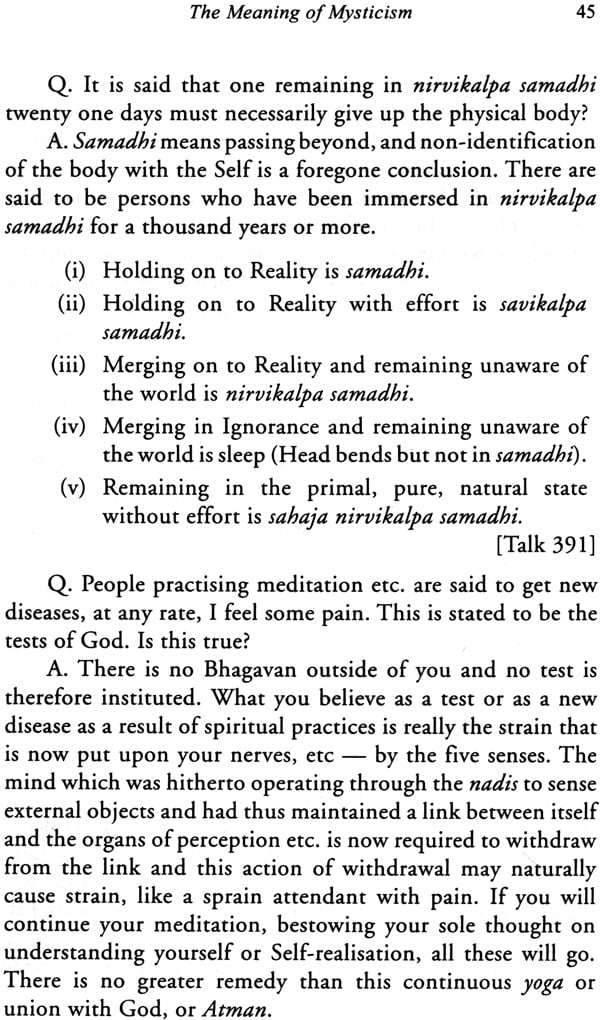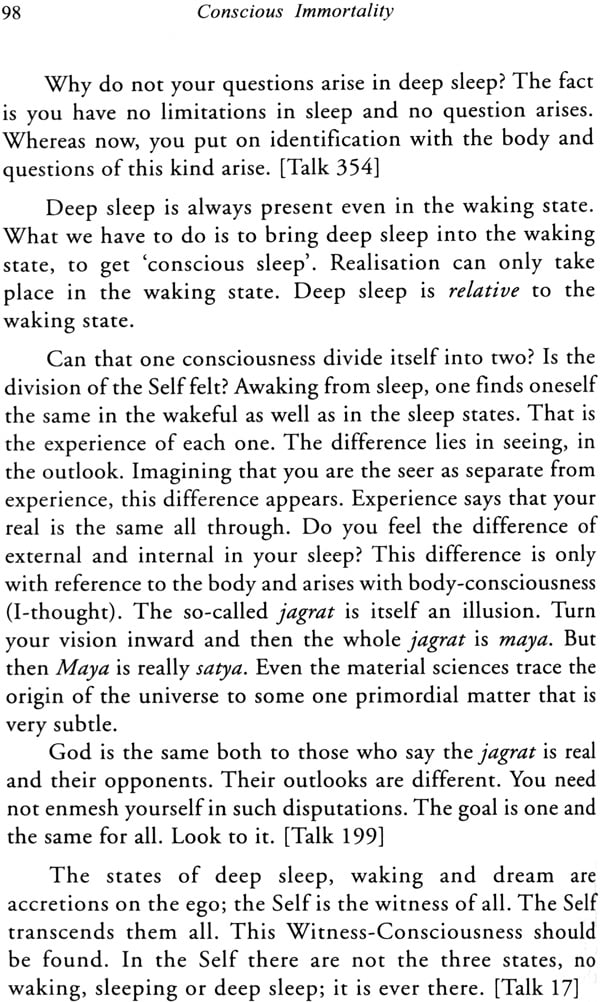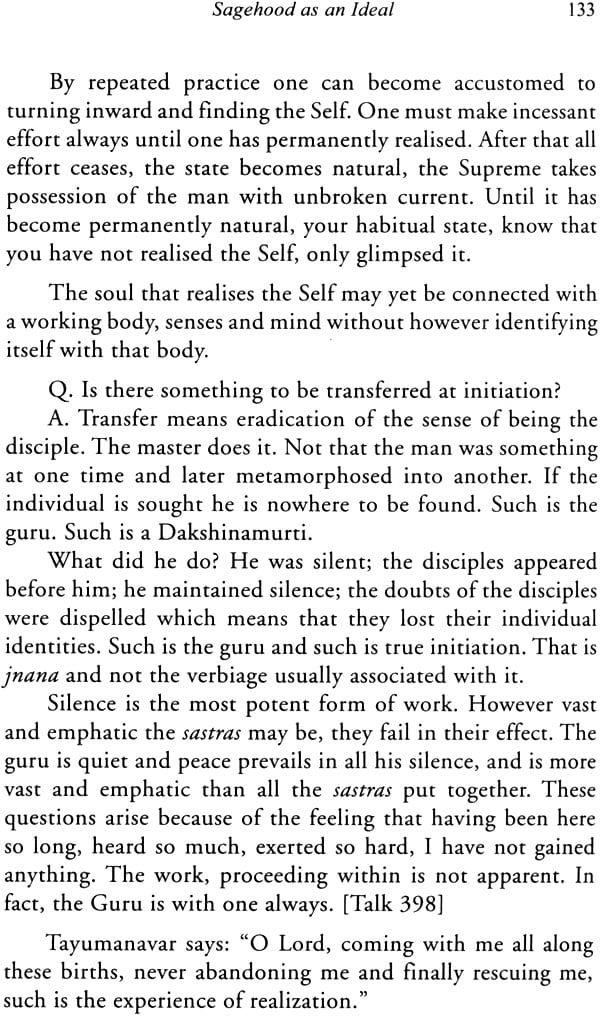
Conscious Immortality (Conversations With Sri Ramana Maharshi Recorded by Paul Brunton)
Book Specification
| Item Code: | NAK188 |
| Author: | Ramana Maharshi |
| Publisher: | Sri Ramanasramam, Tamil Nadu |
| Language: | English |
| Edition: | 2013 |
| ISBN: | 9788182881785 |
| Pages: | 208 |
| Cover: | Paperback |
| Other Details | 8.5 inch x 5.5 inch |
| Weight | 250 gm |
Book Description
This is the fourth revised edition of Conscious Immortality first published in 1983. It is a record of conversations and observations made by Paul Brunoton and Mungala S. Veskataramiah, the complier of Talks with Sri Ramana Maharshi During the second half of the 1930s. just over half the record in Conscious Immortality can also befound in talks.
Since Brunton's notebook is a historical document, the ashram has reprinted the notebook adhering as closely as possible to its original format and style. The editing has been minimal.
There is a wealth of instruction in the notebook and the devotees can gain immeasurably from this new edition.
The title Conscious Immortality originates from a phrase in the notebook of Paul Brunton that was presented to the ashram in 1983 by his son, Kenneth Hurst. The ashram decided to publish the notebook immediately and presented the first copy to Mr. Hurst during his ashram visit in 1983. Due to the pressure of time, the work was hastily edited and contained a number of typing errors. A second improved edition was printed a few years later with some additional material from another source. A third edition was published in 1996 that focused primarily on arranging the subject matter according to topics rather than retaining the page order found in the original notebook. For various reasons, it was decided that Conscious Immortality should not be republished.
It was claimed the original manuscript was lost at the printers in Bangalore during the first press run. However, in those days before photocopy machines, a Ramana devotee managed to type out the entire manuscript before it went to Bangalore and this became the basis of the third, completely revised edition and this fourth, entirely new edition.
It is unfortunate the original manuscript was lost because we would have had a clearer idea of what was removed from the manuscript. Some chapters are quite short and abrupt with pages missing, while some of the original chapters are entirely absent. It was reported that Kenneth Hurst also cut out some passages that dealt with Brunton Personally.
Because the manuscript was lost, we cannot confirm that the typed copy sub-heading conforms exactly to the heading of the original manuscript. The typed copy says; 'Unpublished Commentaries of Sri Ramana Maharshi ( A manuscript recorded partly by Paul Brunton Ph.D. and partly by Mungala S. Venkataramiah).
Since Brunton's notebook is a historical document, it was determined to reprint the notebook this time adhering as closely as possible to its original format and style. The editing has therefore been minimal. For example, sentences awkward in style or structure have not been edited if the meaning is clear. Original sentences that are cryptic or are missing essential grammar have been slightly edited for clarity. We have included nearly all the exchanges and observations that were excluded from the earlier editions.
Brunton did not intend to publish this notebook in its original form and many of the notes were noticeably written in haste. One plausible explanation is that Brunton was compiling quotations from Bhagavan to publish later in a book, which if true, was obviously abandoned. The fact that the notebook was found among his papers after his death in 1981 is indicative of the value placed on it, particularly in the light of his peripatetic existence.
The notebook aside from three quotes from 1938, contains conversations written from January 1935 to May 1937 during Paul Brunton's second visit to the ashram. During this period, Munagala S. Venkataramiah recorded in a large ledger the interchanges between Bhagavan and devotees and visitors that took place mainly in the Old Hall. This handwritten compendium of dialogue was eventually published under the title Talks with Sri Ramana Maharshi Venkataramiah also served as the Principal translator from Tamil to English during Brunton's visits 1935 to 1937 and in 1939.
In the process of preparing this edition, Brunton's notebook was analyzed, and it was discovered that nearly 62% of the material corresponds to text in Talks with Sri Ramana Maharshi. The other 38% of Brunton's notewbook could not be associated with any content from Talks. Of the 62% of Brunton's notes that correspond to material in Talks, 67% of that text matches word for word the text in Talks, and 33% of the text expresses the same incident or conversation in a different manner. When compared with the sole surviving handwritten ledger of Venkataramiah, which contained Talk 189 to Talk 336, was that Brunton's notes followed the original ledger handwriting, which differs slightly in places from the talks first published in 1955 that was edited by Alan Chadwick.
Considering the data just mentioned, the question of attribution arises: who was the principal author of the recorded dialogue contained in Conscious Immortality? One line of argument contends that Brunton heavily borrowed material directly from the handwritten ledgers of Venkataramiah. From what we understand, the ledgers were kept in the Old Hall and devotees had ready access to them. However, this hypothesis does not Provide any explanation for the 38% if Brunton's notes that cannot be attribute to any content found in venkataramiah's Talks or the variations in reports of Conversations made by both participants. Brunton was a journalist by profession, an inquisitive intellectual and inveterate not taker. Why would Brunton Borrow from the ledgers when he was he was present for many of the conversations? Brunton was himself taking notes of dialogue in the Old Hall before being banned from the practice by the Saradhikari (the ashram manager) and perhaps this could also be a reason Brunton copied extensively from the ledgers. It may also be that if Brunton was regularly in the Old Hall, Venkataramiah may have noted down questions asked by Brunton and answers by Bhagavan without directly mentioning Brunton's participation if it was a regular occurrence.
In this respect it may be argued that during his second visit onwards, Brunton collaborated closely with venkataramiah. This would not be surprising as venkataramiah was then the principal interpreter and Brunton would have had frequent interaction with him. Their common note – taking pursuit and reverence for the words of Sri Bhagavan must have generated some mutual attraction. Both were highly intelligent and dedicated men who may have found in their common quest a friendship of kindred souls. Venkataramiah was a congenial, gifted scholar who would have found in Brunton, whose 1934 book A Search in Secret India earned worldwide success, a bright intellect and a friendly personality. The two may also have shared their notes, but this is only a conjecture based on the limited information available.
Also, if two people are taking notes of a discussion between Bhagavan and someone else, it would be very strange if the notes notes differed to any significant degree. However, it is interesting to see how they do differ.
We can see from some examples the disparity when they both attended the same question and answer session as recoded, say, on 29th November 1936 in Talk 288, relating to maya and vedanta. Brunton's notes of Bhagavan's explanations (on page 75 of this edition) show an abbreviated and, it seems a hurried documentation of the same episode.
Venkataramiah's record is much more detailed and coherent.
Another example is Talk 202 (quoted on page 22 of this edition) in which Venkataramiah's question and answer format is reduced to a summary of the conversation by Brunton. One explanation for this difference is that while Venkataramiah considered himself an amanuensis rather than an author and was concerned with accurate documentation, Brunton, on the other hand, made notes of the conversations for his own understanding with a possible view to incorporate them in a more refined form in any future book he might write.
| 1 | Beyond Yoga | 1 |
| 2 | Fallacies of Religion | 9 |
| 3 | The Meaning of Religion | 10 |
| 4 | The Meaning of Mysticism | 14 |
| 5 | The Meaning of Philosophy | 49 |
| 6 | The Intellect | 53 |
| 7 | Characteristics of Philosophic Discipline | 54 |
| 8 | Philosophy of Sensation and Perception | 59 |
| 9 | Illusions of Space, Time and Externality | 60 |
| 10 | The Doctrine of Mentalism | 62 |
| 11 | The Illusion of world Experience | 67 |
| 12 | The Illusion of Ego Experience | 75 |
| 13 | Avasthatraya | 92 |
| 14 | The Ultimate as Truth | 105 |
| 15 | Practical Philosophy | 114 |
| 16 | Sagehood as an Ideal | 131 |
| 17 | The Doctrine of Non-Causality | 152 |
| 18 | The Mind | 155 |
| 19 | The Ultimate as Reality | 166 |
| 20 | The Need of Ultra Mysticism | 182 |
| 21 | Eastern and Western Thinkers | 191 |











